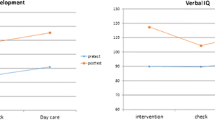Abstract
Background
Affordance is the tendency to encouraged of growth changes. It involves providing critical assistances and encouraging or training learners.
Objective
The purpose of this study was to determine the effects of environmental affordances on motor development in children with intellectual disability.
Methods
This was a quasi-experimental study. Target population included 175 children (6–9 years old) with intellectual disability living in Babol in 2017. Among them, 50 children were conveniently recruited and randomly divided into two groups: experimental and control group (25 per each group). The experimental group went under a specific program including the environmental affordances, such as facilities, training, and exercises focusing on motor skills development of children. The intervention lasted for 36 weeks, three sessions per week, and 30–45 min per session. Bruininks–Oseretsky Test of Motor Proficiency was used to assess the motor skills development of participants. Analysis of covariance was used to analyze the collected data.
Results
The obtained results revealed that affordances had impact on upper parts of the body coordination (p = 0.02), agility (p = 0.04), balance (p = 0.04), response rate (p = 0.6) and power (p = 0.03). Also, results of the study showed that affordance had no impact on the variables of motor–visual, speed and dexterity of the upper parts in the study (p = 0.13).
Conclusion
In conclusion, there should be special attention to the environmental affordances for enhancing motor skills development in children with intellectual disability. Considering the benefits of the assigned protocol in the present study, it could be used as a complementary and alternative medicine for motor skills development in children with intellectual disability without the side effects owing to medication.
Similar content being viewed by others
References
Guliver FP (1908) Orientation of maps. J Geogr 7:55–58
Trowbridge CC (1913) On fundamental methods of orientation and imaginary maps. Science 38:888–897
Pellicano A, Borghi AM, Binkofski F (2017) Bridging the theories of affordances and limb apraxia. Front Hum Neurosci 11:148
Bell PA et al (1996) Environmental psychology. Harcourt, York
Kuh LP, Ponte I, Chau C (2013) The impact of a natural playscape installation on young children’s play behaviors. Child Youth Environ 23(2):49–77
Danks SG (2010) Asphalt to ecosystems: design ideas for schoolyard transformation. New Village Press, New York
Müller AB, Valentini NC, Bandeira PFR (2017) Affordances in the home environment for motor development: validity and reliability for the use in daycare setting. Infant Behav Dev 47:138–145
Geuze RH (2018) On constraints and affordances in motor development and learning—the case of DCD. A commentary on Wade and Kazeck. Hum Mov Sci 57:505–509
Bjørgen K (2016) Physical activity in light of affordances in outdoor environments: qualitative observation studies of 3–5 years olds in kindergarten. Springerplus 5(1):950
Gallahue DL, Ozmun JC, Goodway J (2006) Understanding motor development: infants, children, adolescents, adults. McGraw-Hill, Boston
Janssen AJ, Van Dolder DE, Kollée R, Oostendorp LA, Nijhuis-van der Sanden RA (2012) Development of a movement quality measurement tool for children. Phys Ther 92(4):574–594
Cohen P, West SG, Aiken LS (2014) Applied multiple regression/correlation analysis for the behavioral sciences. Psychology Press, New York
Silverman W et al (2010) Stanford-Binet and WAIS IQ differences and their implications for adults with intellectual disability (aka mental retardation). Intelligence 38(2):242–248
Farid F et al (2015) The comparison of diagnostic validity of new version of tehran- stanford binet intelligence scales (TSB-5) and wechsler intelligence scales for children—fourth edition (WISC-4) in children with learning disability. J Learn Disabil 4(2):70–83
Wilson BN et al (1995) Use of the Bruininks–Oseretsky test of motor proficiency in occupational therapy. Am J Occup Ther 49(1):8–17
Homayounnia M et al (2018) The effects of environmental affordances on perception of vision and balance in children with intellectual disability. Mot Behav 9(30):165–182
Prieske B et al (2015) Affordances in a simple playscape: are children attracted to challenging affordances? J Environ Psychol 41:101–111
Delacato CH (1974) The ultimate stranger: the autistic child. Doubleday, Oxford
Storli R, Hagen TL (2010) Affordances in outdoor environments and children’s physically active play in pre-school. Eur Early Child Educ Res J 18(4):445–456
Johnson DC, Wade MG (2009) Children at risk for developmental coordination disorder: judgement of changes in action capabilities. Dev Med Child Neurol 51(5):397–403
Sheikh M et al (2014) The effects of selected physical activities on perceptual motor ability in pre-school children with neuropsychological learning disabilities. Arch Rehabil 15(3):36–43
Miquelote AF, Santos DC, Caçola PM, Montebelo MI, Gabbard C (2012) Effect of the home environment on motor and cognitive behavior of infants. Infant Behav Dev 35(23):329–334
Acknowledgements
The authors would like to thank all the participants and their families, and the employees of the Center for the Development of Children with Mental Disorders who sincerely have collaborated with the researchers.
Author information
Authors and Affiliations
Corresponding author
Ethics declarations
Conflict of interest
The authors declare they have no conflict of interest.
Ethical approval
The study procedure, consent form, and measures were confirmed by the Ethic Committee of the University of Tehran (code number = IR.UT.SPORT.REC.1396020). The authors declarate that this manuscript and research has been developed based on the Helsinki statement of ethical principles.
Informed consent
Written informed consent was obtained from all individual participants included in the study.
Additional information
Publisher’s Note
Springer Nature remains neutral with regard to jurisdictional claims in published maps and institutional affiliations.
Rights and permissions
About this article
Cite this article
Homayounnia Firoozjah, M., Sheikh, M., Hemayattalab, R. et al. The influence of environment potentiality (affordances) on motor development in 6–9 years old children with intellectual disability. Sport Sci Health 15, 497–502 (2019). https://doi.org/10.1007/s11332-019-00535-3
Received:
Accepted:
Published:
Issue Date:
DOI: https://doi.org/10.1007/s11332-019-00535-3




